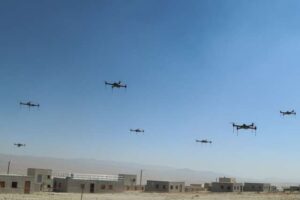
image: public domain
MIT Researchers Develop Algorithm Preventing Midair Drone Collisions
by DRONELIFE Staff Writer Ian M. Crosby
In 2020, MIT researchers presented MADDER, a system designed to prevent crashes between drones occupying the same airspace.
Continue reading below, or listen:
The multiagent trajectory-planner enables a group of drones to form trajectories to avoid collision, with each drone broadcasting its trajectory and in turn considering the trajectories of its fellow drones when charting its course.
MADER is an asynchronous, decentralized, multiagent trajectory-planner. Each drone generates its own trajectory, and although each agent must agree on every new trajectory, they needn’t agree simultaneously. This method renders MADER more scalable than alternative solutions, due to the extensive difficulty of getting large quantities of drones to agree on a trajectory at the same time.
However, testing the system on real drones found that a drone lacking up-to-date information on the trajectories of its partners could cause collisions. This led researchers to develop the updated Robust MADER, a multiagent trajectory planner formulating collision-free trajectories even with delayed communications between drones.
“MADER worked great in simulations, but it hadn’t been tested in hardware. So, we built a bunch of drones and started flying them,” said Kota Kondo, an aeronautics and astronautics graduate student. “The drones need to talk to each other to share trajectories, but once you start flying, you realize pretty quickly that there are always communication delays that introduce some failures.”
This new system’s algorithm introduces a delay-check step in which a drone waits a specified amount of time before following a new trajectory. Receiving additional trajectory information during the delay period may cause it to abandon its planned trajectory and start over if necessary. According to Kondo, the length of the delay-check period depends on the distance between drones and environmental factors with the potential to obstruct communications.
Robust MADER achieved a 100 percent success rate at creating collision-free trajectories, both in simulations and with real drones. Although this new system resulted in marginally slower travel time, it was the only method that guaranteed safety.
“If you want to fly safer, you have to be careful, so it is reasonable that if you don’t want to collide with an obstacle, it will take you more time to get to your destination. If you collide with something, no matter how fast you go, it doesn’t really matter because you won’t reach your destination,” Kondo says.
Kondo wrote the paper alongside Jesus Tordesillas, a postdoc; Parker C. Lusk, a graduate student; Reinaldo Figueroa, Juan Rached, and Joseph Merkel, MIT undergraduates; and senior author Jonathan P. How, the Richard C. Maclaurin Professor of Aeronautics and Astronautics, a principal investigator in the Laboratory for Information and Decision Systems (LIDS), and a member of the MIT-IBM Watson AI Lab. Their research is to be presented at the International Conference on Robots and Automation.
In order to test this new solution, the team of researchers carried out hundreds of simulations in which they artificially introduced communication delays. Robust MADER was 100 percent successful at formulating collision-free trajectories in all of these simulations, while conversely all of the tests completed while employing its predecessor resulted in collisions.
The researchers additionally constructed six drones and two aerial obstacles, testing Robust MADER in a multiagent flight environment. The results of these tests found that, while utilizing the original version of MADER in this environment would have caused a total of seven collisions, Robust MADER did not result in a single crash during any of the hardware experiments.
“Until you actually fly the hardware, you don’t know what might cause a problem. Because we know that there is a difference between simulations and hardware, we made the algorithm robust, so it worked in the actual drones, and seeing that in practice was very rewarding,” said Kondo.
Drones utilizing Robust MADER were able to fly 3.4 meters per second, albeit with a marginally longer average travel time than some baselines. However, Robust MADER was the only method to be perfectly collision-free throughout every experiment.
Going forward, Kondo and his collaborators intend to test Robust MADER in an outdoor environment, where a wide variety of obstacles and sources of noise have the potential to impede communications. The research team also hopes to equip the drones with visual sensors, enabling them to detect other agents or obstacles, predict their movements, and factor that information into their trajectory optimizations.
Read more:
Ian attended Dominican University of California, where he received a BA in English in 2019. With a lifelong passion for writing and storytelling and a keen interest in technology, he is now contributing to DroneLife as a staff writer.
Miriam McNabb is the Editor-in-Chief of DRONELIFE and CEO of JobForDrones, a professional drone services marketplace, and a fascinated observer of the emerging drone industry and the regulatory environment for drones. Miriam has penned over 3,000 articles focused on the commercial drone space and is an international speaker and recognized figure in the industry. Miriam has a degree from the University of Chicago and over 20 years of experience in high tech sales and marketing for new technologies.
For drone industry consulting or writing, Email Miriam.
TWITTER:@spaldingbarker
Subscribe to DroneLife here.
https://dronelife.com/2023/04/02/mit-researchers-develop-new-algorithm-to-prevent-drone-collisions/
 Unmanned Aerial Vehicle The latest drone news
Unmanned Aerial Vehicle The latest drone news



